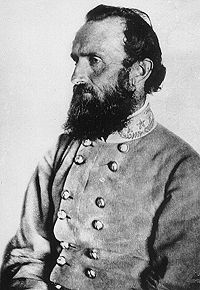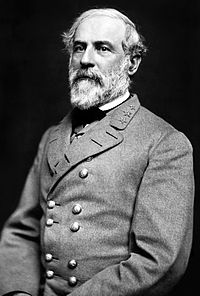May 3 –
Confederate General Thomas “Stonewall” Jackson administers a devastating defeat to the Army of the Potomac, command by General Joseph Hooker, at the Battle of Chancellorsville, Virginia.

In one of the most stunning upsets of the war, a vastly outnumbered Army of Northern Virginia sent the Army of the Potomac, commanded by General Joseph Hooker, back to Washington, D.C., in defeat.

Hooker, who was headed for Robert E. Lee’s Confederate army, was both confident and numerically superior. He had sent part of his force to meet Lee’s troops at Fredericksburg, Virginia, the day before, while the rest swung west to approach Lee from the rear. Meanwhile, Lee

had left part of his army at Fredericksburg and had taken the rest of his troops to confront Hooker near Chancellorsville. When the armies collided on May 1, Hooker withdrew into a defensive posture. Sensing Hooker’s trepidation, Lee sent Jackson along with 28,000 troops on a swift, 14-mile march around the Union right flank. Splitting his army into three parts in the face of the mighty Army of the Potomac was a bold move, but it paid huge dividends for the Confederates. Although Union scouts detected the movement as Jackson swung southward, Hooker misinterpreted the maneuver as a retreat. When Jackson’s troops swung back north and into the thick woods west of Hooker’s army, Union pickets reported a possible buildup; but their warnings fell on deaf ears.

On the evening of May 2, Union soldiers from General Oliver Otis Howard’s 11th Corps were cooking their supper and playing cards when waves of animals charged from the woods. Behind them were Jackson’s attacking troops. The Federal flank crumbled as Howard’s men were driven back some two miles before stopping the Rebel advance. Despite the Confederate victory at the Battle of Chancellorsville, Union forces soon gained the upper hand in the war in the eastern theater.
But the victory was soon soured for the Confederacy. Anxious to push his advantage and wipe the Union Army from the field, Jackson was unwilling to let the matter rest. Always a tiger when he was on the field, Jackson took a few of his officers on a scout forward of his own the lines to find a path behind the remainder of the Union so he could attack them from both sides. Scouting in front of the lines as they returned in the dark, Jackson and his aides were fired upon by their own troops. When told of Jackson’s wounding, Lee is reported to have said “He may have lost his left arm, but I have lost my right.”
Jackson’s left arm was amputated the next morning, and he never recovered. He died from complica-tions from pneumonia a week later, leaving Lee without his most able lieutenant. Jackson was the one man Lee could depend upon to make the most of any victory and minimize any loss. His loss was a significant one for the Confederacy, and it was no more apparent than next month in a little town in Pennsylvania, when the tide went out for the Confederacy.
To purchase a signed copy of Larry Auerbach’s novel “The Spirit Of Redd Mountain”, Click Here
Photo courtesy of wikipedia.com

